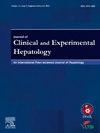Comparison of Serological Immune Response to Hepatitis B Vaccine Following Rapid or Standard Regimen in People Who Inject Drugs
IF 3.3
Q2 GASTROENTEROLOGY & HEPATOLOGY
Journal of Clinical and Experimental Hepatology
Pub Date : 2025-01-09
DOI:10.1016/j.jceh.2025.102501
引用次数: 0
Abstract
Background & Aims
The standard regimen of hepatitis B vaccination, i.e., three doses at 0, 1, and 6 months, protects 90–95% of vaccine recipients. Compliance for three doses, administered over six months, is particularly low among people who inject drugs (PWIDs). To prevent hepatitis B virus (HBV) infection, the World Health Organization has recommend to vaccinate PWIDs with an accelerated regimen, i.e., in a 0-, 7-, and 21-day schedule. We compared the serological immune response with standard and accelerated vaccination regimens in PWIDs.
Methods
PWIDs were vaccinated with three doses of hepatitis B vaccine as a part of routine preventive services in the past, which was not the part of our research work. Each of them had taken a conscious and informed decision to choose either the standard or accelerated regimen at the time of vaccination. For this cross-sectional observational study, anti-HBs (anti-HBs) titers were measured in vaccine recipients at ≥3 months after the administration of the third dose of vaccine. Vaccine-induced seroconversion was defined as presence of detectable anti-HBs titer, and seroprotection was defined as anti-HBs titer measuring ≥10 mIU/mL. Numerical and categorical data are expressed as median (interquartile range) and percentage (proportion), respectively; groups were compared using nonparametric tests.
Results
The study included 567 PWIDs (all men; age: 29 [24–38] years) vaccinated with either the accelerated (n = 356; 62.8%) or standard (n = 211; 37.2%) regimen. Participants’ ages were comparable (P = 0.99) in accelerated (29 [24–38.5] years) and standard (29 [24–37] years) groups. The interval between the last dose of vaccine and anti-HBs titer estimation was significantly longer in the accelerated group (487 [422–625]) than in the standard group (176 [105–211] days) (P < 0.001). A higher proportion achieved seroconversion in the standard group than in the accelerated group (99.5% vs 91.9%; P < 0.001). Among those who achieved seroconversion, a larger proportion in the standard group were seroprotected than in the accelerated group (99.5% vs. 92.1%; P < 0.001). Anti-HBs titer was significantly higher in the standard group (2404 [412–12450] mIU/mL) than in the accelerated group (247 [57–1250] mIU/mL) (P < 0.001).
Conclusions
Accelerated regimen of hepatitis B vaccination is well accepted among PWIDs and provides seroprotection to a large proportion of vaccine recipients, though the vaccine-induced antibody titers remain relatively lower. For high-risk groups such as PWIDs and other mobile population groups, an accelerated vaccination regimen may be a reasonable alternative to the standard vaccination schedule.

注射吸毒者快速或标准方案乙肝疫苗血清学免疫反应的比较
背景,标准的乙肝疫苗接种方案,即在0、1和6个月接种三剂,可保护90-95%的疫苗接种者。注射吸毒者(PWIDs)的依从性在六个月内给予三剂药物的情况特别低。为了预防乙型肝炎病毒(HBV)感染,世界卫生组织建议对PWIDs进行加速接种,即按0天、7天和21天进行接种。我们比较了PWIDs的血清学免疫反应与标准和加速疫苗接种方案。方法在以往的常规预防服务中,曾接种过三剂乙型肝炎疫苗,但这并非我们的研究内容。他们每个人都在接种疫苗时做出了有意识和知情的决定,选择标准方案或加速方案。在这项横断面观察性研究中,在接种第三剂疫苗后≥3个月测量疫苗接种者的抗hbs(抗hbs)滴度。疫苗诱导的血清转化定义为存在可检测的抗hbs滴度,血清保护定义为抗hbs滴度≥10 mIU/mL。数值和分类数据分别用中位数(四分位数间距)和百分比(比例)表示;各组采用非参数检验进行比较。结果该研究包括567名pwid患者(均为男性;年龄:29[24-38]岁)接种加速疫苗(n = 356;62.8%)或标准(n = 211;37.2%)方案。加速组(29[24-38.5]岁)和标准组(29[24-37]岁)的参与者年龄相当(P = 0.99)。加速组最后一次接种疫苗和估计抗hbs滴度之间的时间间隔(487[422-625])明显长于标准组(176[105-211]天)(P <;0.001)。标准组血清转化比例高于加速组(99.5% vs 91.9%;P & lt;0.001)。在实现血清转化的患者中,标准组的血清保护比例高于加速组(99.5% vs. 92.1%;P & lt;0.001)。标准组抗hbs滴度(2404 [412-12450]mIU/mL)显著高于加速组(247 [57-1250]mIU/mL) (P <;0.001)。结论加速乙肝疫苗接种方案在PWIDs中被广泛接受,并为大部分疫苗接种者提供了血清保护,尽管疫苗诱导的抗体滴度仍然相对较低。对于高危人群,如pwid患者和其他流动人口群体,加速疫苗接种方案可能是标准疫苗接种计划的合理替代方案。
本文章由计算机程序翻译,如有差异,请以英文原文为准。
求助全文
约1分钟内获得全文
求助全文
来源期刊

Journal of Clinical and Experimental Hepatology
GASTROENTEROLOGY & HEPATOLOGY-
CiteScore
4.90
自引率
16.70%
发文量
537
审稿时长
64 days
 求助内容:
求助内容: 应助结果提醒方式:
应助结果提醒方式:


